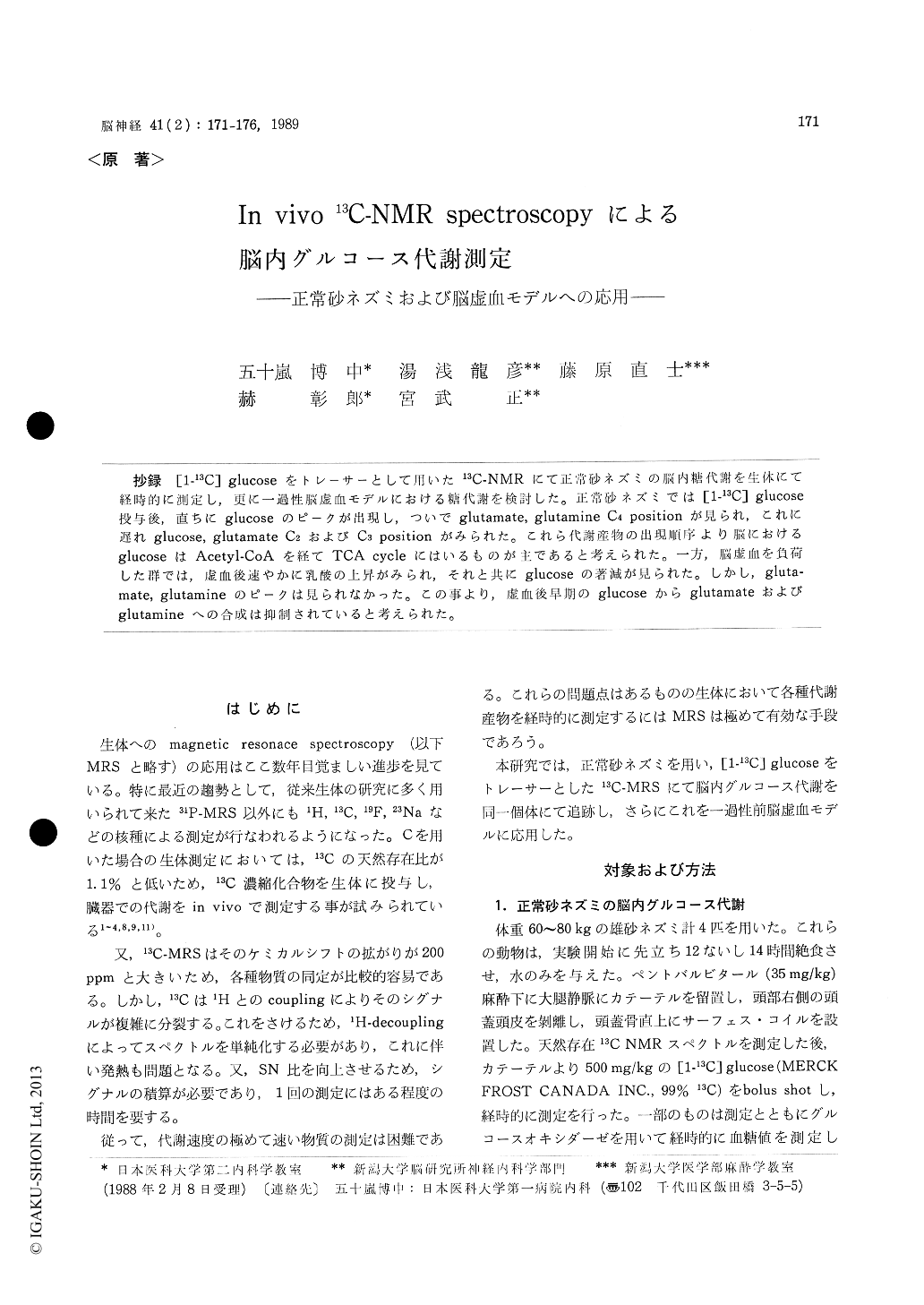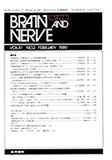Japanese
English
- 有料閲覧
- Abstract 文献概要
- 1ページ目 Look Inside
抄録 [1-13C]glucoseをトレーサーとして用いた13C-NMRにて正常砂ネズミの脳内糖代謝を生体にて経時的に測定し,更に一過性脳虚血モデルにおける糖代謝を検討した。正常砂ネズミでは[1-13C]glucose投与後,直ちにglucoseのピークが出現し,ついでglutamate, glutamine C4 positionが見られ,これに遅れglucose, glutamate C2およびC3 positionがみられた。これら代謝産物の出現順序より脳におけるglucoseはAcetyl-CoAを経てTCA cycleにはいるものが主であると考えられた。一方,脳虚血を負荷した群では,虚血後速やかに乳酸の上昇がみられ,それと共にglucoseの著減が見られた。しかし,gluta-mate, glutamineのピークは見られなかった。この事より,虚血後早期のglucoseからglutamateおよびglutamineへの合成は抑制されていると考えられた。
、
Glucose metabolism is altered in various patho-logic conditions in the brain, i. e. ischemia, epilepsy and hypoglycemia. Therefore, analysis of glucose metabolism in pathologic conditions needs careful investigation of that in steady state. 13C-NMR method allows continuous sequen-tial monitoring of changes in metabolism of glucose in vivo. The natural abundance of 13C is quite low (1.1%) and by administering 13C labelled in various skeleton in glucose, it is possible to monitor the metabolites in vivo. In this study, 13C glucose labelled in 1-position of carbon was employed to investigate the metabolic pathways in the control and transient ischemic gerbil brain with reperfusion.
Male mongolian gerbils weighing 60-80 g were employed in this study. The gerbils were anes-thetized by intraperitoneal administration of pentobarbital. The right skull was exposed and a surface coil was placed directly above the skull bone. After the operation, the animals were fastened to the NMR probe vertically. 500 mg/kg of [1-13C] glucose was injected via femoral ca-theter. 13C-NMR spectra were serially obtained before and after injection with GX-270 NMR spectrometer (JEOL, Tokyo, Japan, 6.34 T). In other series of experiments, 30 mintutes of cere-bral ischemia were induced after 15 minutes of glucose injection by the bilateral common carotid artery occlusion.
In the normal gerbil brain, after administra-tion of [1-13C] glucose (500 mg/kg), alpha andbeta-anomors of [1-13C] glucose peak apperared abruptly and reached its peak level at 7.5-15 min aquisition period. The C 2 peak representing glu-tamate and/or glutamine appeared later. The C 3 and C 4 peak started to appear even later at 30-40 min. From the present result, it can be sug-gested that major amino acid synthesized from the glucose in brain may be glutamate and glutamine and the pathway via Acetyl-CoA may be the major pathway for entering TCA-cycle in glucose. In the transient ischemic group, immediately after induction of ischemia, the C3 representing lactate appeared and reached plateau within 15 min and glucose peak went down during ischemia. After recirculation, lactate peak was declined gradually, and disappeared after 45 minutes. On the other hand, the peaks of glutamate or glutamine were never seen during and after the transient ischemia. During the ischemia, anaerobic glycolysis is much accelerated with Pasteur effect, and TCA cycle is uncoupled by decrease of O2 consumption. Thus glutamate and glutamine synthesis from glucose may be suppressed. During recovery, TCA cycle recovers within 30 minutes of recirculation and dominant route for lactate clearance from brain is oxidation through TCA cycle. Thus glutamate and glutamine is thought to be synthesized from alphaketo-glutarate of the metabolite in TCA cycle. But the peaks of glutamate and/or glutamine were never detected. From the present results we can suggest that glutamate and glutamine synthesis from the glucose depressed after 30 min of tran-sient ischemia.

Copyright © 1989, Igaku-Shoin Ltd. All rights reserved.


